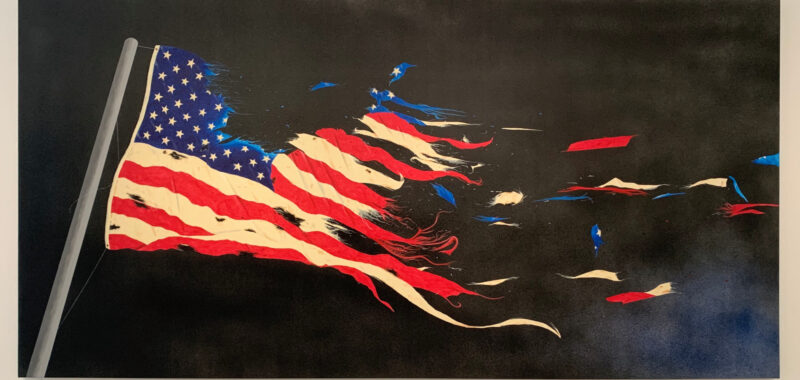LOS ANGELES — For more than six decades, Ed Ruscha has been an innovator in exploring the relationships between words, images, and materials. Drawing inspiration largely from the unique landscape and culture of Los Angeles, he has made pioneering contributions to the genres of Pop Art, artist books, and even immersive olfactory art. The first comprehensive survey of Ruscha’s work in 20 years, at the Los Angeles County Museum of Art (LACMA), sheds new light on the veteran artist, tracing his career from his earliest to more recent paintings, reminding viewers that he is a master wordsmith, an expert formalist, and an accomplished philosopher and poet.
In the early 1960s, Ruscha developed an approach to Pop Art that negotiated other recent art movements through paintings influenced by commercial signage, consumer product labels, and fonts and words used in comics and graphic novels. “Actual Size” (1962), for instance, replicates an exploding can of Spam to scale below an enlarged reproduction of the product’s logo in a Pop Art style, yet achieves its visceral impact from broad yellow brush gestures and dripped paint streaks, stylistic traits of Abstract Expressionism that here simulate the sounds of the explosion.


In the exquisite “Noise, Pencil, Broken Pencil, Cheap Western” (1963), Ruscha cleverly sabotaged the usual figure/ground relationship by moving his subjects — the word “NOISE,” a broken and unbroken pencil, and a pulp-fiction magazine — to the canvas’s edges, leaving at the core a dark blue expanse suggestive of the Color Field paintings of Mark Rothko, Barnett Newman, Ad Reinhardt, and Ellsworth Kelly. So there are two compositions in one: a conceptual game of connecting words and images that appeals to the intellect, and a lush abstraction that touches our emotions. In subsequent language-based works, he painted trompe l’oeil words that appear to be made of liquid in “Annie, Poured from Maple Syrup” (1966), removed text from where it should normally appear in “Unidentified Hit Record” (1977), superimposed an incongruous phrase over imagery painted by another artist in “The Music from the Balconies” (1984), and replicated the effect of the closing title of a film stuck in a projector in “The End” (1991).
LA’s sprawling, ever-changing landscape has been a subject for Ruscha since the 1960s, when the Bechers were documenting industrial structures. The artist inventoried vacant Los Angeles parking lots from a helicopter, presenting them in both photographic and book form, and cataloged swimming pools and apartment buildings in gunpowder-and-pastel drawings. For his book “Every Building on the Sunset Strip” (1966), he photographed 1.5 miles, or around 2.4 kilometers, of continuous real estate from both sides of the street, conveying a sense of how Angelinos experience their environs from a moving car. And for the 2005 Venice Biennale, he examined urban renewal by juxtaposing paintings of the same buildings painted more than ten years apart.
In more recent investigations of environmental and cultural metamorphoses, Ruscha shifted beyond the parameters of Los Angeles. His colossal horizontal diptych “Azteca/Azteca in Decline” (2007) depicts a mural near a Mexican archeological site, intact in one panel and deconstructed in the other, as a metaphor for the rise and fall of civilizations. “Our Flag” (2017), painted early during the Trump administration, depicts a disintegrating American flag in what can be read as a compelling warning sign about the future of the United States. But think of it instead as one frame from a film strip, and there is room yet for the hopeful idea that that destruction can reversed. As Ruscha demonstrated from the very beginning of his career, one should never accept words or images at face value.

Ed Ruscha: Now Then continues at the Los Angeles County Museum of Art (5905 Wilshire Boulevard) through October 6. The exhibition was organized by Christophe Cherix and Michael Govan with Ana Torok, Kiko Aebi, Rebecca Morse, and Deliasofia Zacarias.

